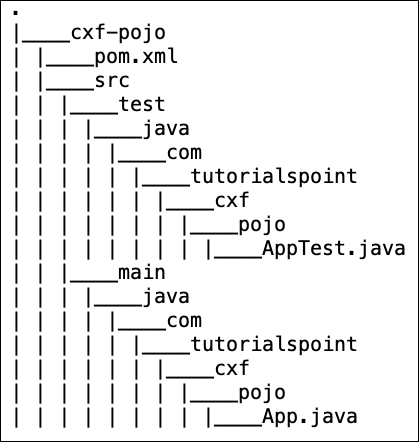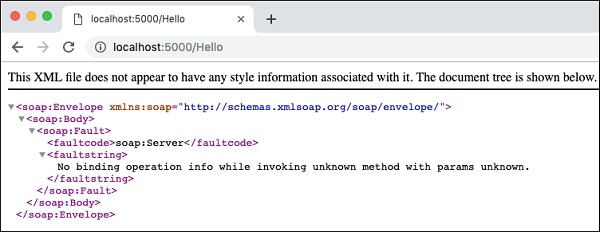
Apache CXF With POJO
Apache CXF with JAX-WS
Apache CXF with WSDL First
Apache CXF With JAX-RS
Apache CXF With JMS
Apache CXF Conclusion
Apache CXF Useful Resources
Apache CXF - Creating a POJO Server
We're creating a maven project using Eclipse. Go to New > Maven Project. Check the Create a simple project option. and choose the following properties −
groupid − com.tutorialspoint
artifactId − cxf-pojo
version − 1.0
After the completion of the wizard, you will find the appropriate folder structure created in your current folder along with pom.xml file.
The generated directory structure is shown here −

You will add the CXF dependencies in the pom.xml. For your ready reference, we have given below the pom.xml file for the project that we created on our machine.
<?xml version = "1.0" encoding = "UTF-8"?>
<project xmlns = "http://maven.apache.org/POM/4.0.0"
xmlns:xsi = "http://www.w3.org/2001/XMLSchema-instance"
xsi:schemaLocation = "http://maven.apache.org/POM/4.0.0
http://maven.apache.org/xsd/maven-4.0.0.xsd">
<modelVersion>4.0.0</modelVersion>
<groupId>com.tutorialspoint</groupId>
<artifactId>cxf-pojo</artifactId>
<version>1.0</version>
<packaging>jar</packaging>
<properties>
<project.build.sourceEncoding>UTF-8</project.build.sourceEncoding>
<maven.compiler.source>24</maven.compiler.source>
<maven.compiler.target>24</maven.compiler.target>
<cxf.rt.version>4.1.3</cxf.rt.version>
</properties>
<profiles>
<profile>
<id>server</id>
<build>
<defaultGoal>test</defaultGoal>
<plugins>
<plugin>
<groupId>org.codehaus.mojo</groupId>
<artifactId>exec-maven-plugin</artifactId>
<executions>
<execution>
<phase>test</phase>
<goals>
<goal>java</goal>
</goals>
<configuration>
<mainClass>
com.tutorialspoint.cxf.pojo.HelloServer
</mainClass>
</configuration>
</execution>
</executions>
</plugin>
</plugins>
</build>
</profile>
</profiles>
<dependencies>
<dependency>
<groupId>org.apache.cxf</groupId>
<artifactId>cxf-rt-features-logging</artifactId>
<version>${cxf.rt.version}</version>
<scope>test</scope>
</dependency>
<dependency>
<groupId>org.apache.cxf</groupId>
<artifactId>cxf-rt-frontend-simple</artifactId>
<version>${cxf.rt.version}</version>
</dependency>
<dependency>
<groupId>org.apache.cxf</groupId>
<artifactId>cxf-rt-transports-http</artifactId>
<version>${cxf.rt.version}</version>
</dependency>
<dependency>
<groupId>org.apache.cxf</groupId>
<artifactId>cxf-rt-frontend-jaxws</artifactId>
<version>${cxf.rt.version}</version>
</dependency>
<!-- Jetty is needed if you're using the CXFServlet -->
<dependency>
<groupId>org.apache.cxf</groupId>
<artifactId>cxf-rt-transports-http-jetty</artifactId>
<version>${cxf.rt.version}</version>
</dependency>
</dependencies>
</project>
The above pom.xml may include additional dependencies which are irrelevant to this project, but are required for our next project in this tutorial. Anyway, there is no harm as such in including additional dependencies.
Project Folder Structure
The project folder structure on my machine after placing the server and client Apache CXF files is shown below for your quick reference −

HelloServer.java
package com.tutorialspoint.cxf.pojo;
import org.apache.cxf.frontend.ServerFactoryBean;
public class HelloServer {
protected HelloServer() throws Exception {
ServerFactoryBean factory = new ServerFactoryBean();
factory.setServiceClass(HelloWorld.class);
factory.setAddress("http://localhost:5000/Hello");
factory.setServiceBean(new HelloWorldImpl());
factory.create();
}
public static void main(String[] args) throws Exception {
new HelloServer();
System.out.println("Listening on port 5000 ...");
Thread.sleep(5 * 60 * 1000);
System.out.println("Server exiting ...");
System.exit(0);
}
}
Running Server
To build the project, use the following command in your command-line window −
mvn clean install
You can start the server using the following command −
mvn -Pserver
This will start the server and you will see the following prompt on the console −
INFO: Creating Service {http://pojo.cxf.tutorialspoint.com/}HelloWorld from class com.tutorialspoint.cxf.pojo.HelloWorld
INFO: Setting the server's publish address to be http://localhost:5000/Hello
Listening on port 5000 ...
Now, in your browser window specify the URL of our published service. You will see the following output −

This confirms that our service is running at the specified port on a localhost. Since we did not specify the greetings message in our call, a SOAP fault message is returned to the browser.
You may further test your web service using a SOAP client of your choice. Here we have used Postman to test our server.
The output is as shown here −

Observe that SOAP Request was hand-coded. After posting the request, the server sent a SOAP Response message, which is seen in the bottom portion of the screen shot.
From this, you can understand that CXF maintains the use of SOAP protocols for both request and response while providing you a unified view to a variety of web technologies that do exist in today's world. This greatly simplifies the web application development.